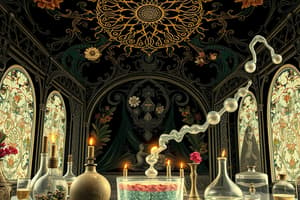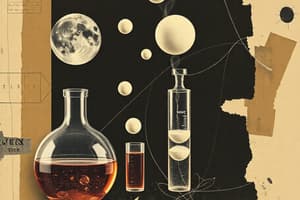Podcast
Questions and Answers
Explain why $K_3N$ is soluble while $Cu(OH)_2$ is not, referring to general solubility rules.
Explain why $K_3N$ is soluble while $Cu(OH)_2$ is not, referring to general solubility rules.
$K_3N$ is soluble because all compounds containing Group 1 cations such as potassium ($K^+$) are soluble. $Cu(OH)_2$ is insoluble because most hydroxide ($OH^−$) compounds are insoluble, except those of Group 1 elements and some Group 2 elements.
If a solution containing lead (II) ions is mixed with a solution containing iodide ions, a precipitate forms. Write the net ionic equation for this precipitation reaction, including state symbols.
If a solution containing lead (II) ions is mixed with a solution containing iodide ions, a precipitate forms. Write the net ionic equation for this precipitation reaction, including state symbols.
$Pb^{2+}(aq) + 2I^-(aq) \rightarrow PbI_2(s)$
In the reaction of aqueous lithium chloride with aqueous lead(II) nitrate, identify the spectator ions. Briefly explain why they are considered spectator ions.
In the reaction of aqueous lithium chloride with aqueous lead(II) nitrate, identify the spectator ions. Briefly explain why they are considered spectator ions.
The spectator ions are lithium ($Li^+$) and nitrate ($NO_3^−$). They are considered spectator ions because they remain aqueous throughout the reaction and do not participate in the formation of the precipitate, lead(II) chloride.
A student attempts to conduct electricity using solid sodium chloride (NaCl), but it fails to conduct. Explain why, and then describe a method to make it conductive.
A student attempts to conduct electricity using solid sodium chloride (NaCl), but it fails to conduct. Explain why, and then describe a method to make it conductive.
Based on the case study information, explain how the presence of blue-grey skin on the victim could assist forensic investigators and the chemical process behind the colour change.
Based on the case study information, explain how the presence of blue-grey skin on the victim could assist forensic investigators and the chemical process behind the colour change.
Write the chemical formulas for calcium sulfide and lead (II) iodide. Explain why the Roman numeral is necessary for lead but not for calcium.
Write the chemical formulas for calcium sulfide and lead (II) iodide. Explain why the Roman numeral is necessary for lead but not for calcium.
Write a balanced chemical equation and the corresponding ionic equation for the reaction between aqueous lithium chloride and aqueous lead(II) nitrate. What type of reaction is this?
Write a balanced chemical equation and the corresponding ionic equation for the reaction between aqueous lithium chloride and aqueous lead(II) nitrate. What type of reaction is this?
A solution of sodium sulfate ($Na_2SO_4$) is mixed with potassium hydroxide ($KOH$). Write a balanced chemical equation for the reaction. Will there be a precipitate?
A solution of sodium sulfate ($Na_2SO_4$) is mixed with potassium hydroxide ($KOH$). Write a balanced chemical equation for the reaction. Will there be a precipitate?
Explain why ionic compounds conduct electricity in the molten or aqueous state but not in the solid state. Use a diagram to support your answer.
Explain why ionic compounds conduct electricity in the molten or aqueous state but not in the solid state. Use a diagram to support your answer.
Based on the case study, the victim's blue-grey skin suggests argyria due to silver ion accumulation. If silver was ingested as silver nitrate ($AgNO_3$), what other chemicals introduced would cause a reaction with silver in the body?
Based on the case study, the victim's blue-grey skin suggests argyria due to silver ion accumulation. If silver was ingested as silver nitrate ($AgNO_3$), what other chemicals introduced would cause a reaction with silver in the body?
Write the chemical formulas for Calcium sulfide and Chromium (III) oxide.
Write the chemical formulas for Calcium sulfide and Chromium (III) oxide.
Write the balanced chemical equation for the reaction between aqueous lithium chloride and aqueous lead(II) nitrate.
Write the balanced chemical equation for the reaction between aqueous lithium chloride and aqueous lead(II) nitrate.
Based on the case study, what evidence suggests the victim suffered from argyria, and how is this condition related to a specific ion?
Based on the case study, what evidence suggests the victim suffered from argyria, and how is this condition related to a specific ion?
Explain why ionic compounds can conduct electricity in molten or aqueous state but not in solid state.
Explain why ionic compounds can conduct electricity in molten or aqueous state but not in solid state.
A solution of sodium sulfate ($Na_2SO_4$) is mixed with potassium hydroxide ($KOH$). Write a balanced equation for this reaction, and state whether a precipitate will form.
A solution of sodium sulfate ($Na_2SO_4$) is mixed with potassium hydroxide ($KOH$). Write a balanced equation for this reaction, and state whether a precipitate will form.
Flashcards
Ionic Compound
Ionic Compound
A compound formed by the electrostatic attraction between ions.
Soluble Ionic Compound
Soluble Ionic Compound
Dissolves in water. Check solubility rules.
Insoluble Ionic Compound
Insoluble Ionic Compound
Does not dissolve in water, forming a solid precipitate.
Ionic Equation
Ionic Equation
Signup and view all the flashcards
Ionic Conductivity
Ionic Conductivity
Signup and view all the flashcards
Soluble Compound
Soluble Compound
Signup and view all the flashcards
Insoluble Compound
Insoluble Compound
Signup and view all the flashcards
K3N Name and Solubility
K3N Name and Solubility
Signup and view all the flashcards
Cu(OH)2 Name and Solubility
Cu(OH)2 Name and Solubility
Signup and view all the flashcards
Mg(CH3COO)2 Name and Solubility
Mg(CH3COO)2 Name and Solubility
Signup and view all the flashcards
Silver Ion Overaccumulation Effect
Silver Ion Overaccumulation Effect
Signup and view all the flashcards
Balanced Chemical Equation
Balanced Chemical Equation
Signup and view all the flashcards




